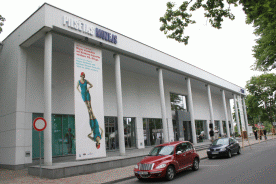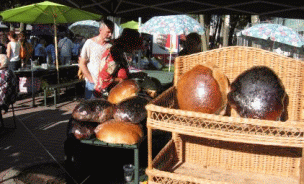|
About Jurmala Information
Souvenirs Transport

The largest resort-town
JURMALA
is situated some 20 km from Riga, on the coast of the Gulf of Riga.
Jurmala is famous for its natural curative features mild climate, sea and
salubrious air, medical mud and spa water. The resort has a unique 32 km long
golden sandy beach, vast pine forests and a blue natural border the Lielupe
River.
Wooden summer cottages, built in the beginning of the last century, rich
decorated with carvings successfully co-exist with the more recent buildings of
spas.
The EU Blue Flag is awarded to the beaches, acknowledging high quality of the
swimming waters, security, First Aid and good service. The whole 32 km long
territory of Jurmala is covered by springs of different mineralization. These
waters are used for inner treatments as well as baths and pools. Nowadays
numerous Jurmala spa hotels welcome their guests to undergo various
combinations of spa-treatments and climatotherapy.
PRIEDAINE - the gate to Jūrmala.
This calm place is located just 14 km from the Capital of Latvia - Rīgas.
Indeed, the name of Priedaine is translated like the pine-forest area. One of
the greatest Jūrmala nature attractions, the 15-17m high, 800m long and 100m
wide Baltā kāpa (the White Dune) is located in Priedaine. In summer one can view
it comfortably from aboard the Rīga Majori Rīga weekend ferry. This
picturesque sand dune is an outcrop of the right bank of the Lielupe River and
was formed in the middle of the 18th c. |
Contacts
JURMALA TOURISM BUREAU -
52
Jomas Street
(entrance from Smilsu Street), Jurmala, LV-2015
(+371) 29027775, 67764493
jurmalatour@apollo.lv
(read
more)
Excursions
-
for individuals,
for
groups and school pupil
Trips
-
theatre and concerts visiting with
excursions
Services
-
scanning, copy, visas, insurance
Journeys
-
by
bus,
by airplane
Hotels
-
guest houses, apartments, camping
Jurmala Tourism Bureau offers:
airplane tickets,
bus tickets for international buses,
ferry tickets,
insurance.
We offer
guide services -
in English, Russian, Latvian and other languages.
With Latvian tour operators we offer travels around the world and a
rest on the South resorts.
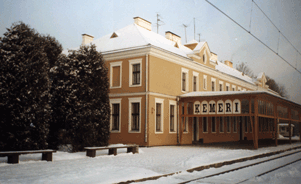 |
|
LIELUPE where history greets nowadays. Being a fishermen's village
once, Lielupe is an elegant summer cottages and dwelling houses area, where
numerous architectural monuments of state significance can be viewed. Lielupe
Railway Station was built in 1913 and has maintained its appearance and
functions till nowadays. Stop for a while at the Lielupe Cemetery. The first
burials date back to the 1880. Several Latvian celebrities are buried here
(writers, publishers etc.). The National Tennis Centre Lielupe is visible in a
short distance. Visiting the Jūrmala Open-Air Museum (1a Tīklu Street). See,
touch and photograph the authentic buildings and equipment belonging once to the
Jūrmala fishermen. Nearby, the Ragakāpa Nature Park is located. A comfortable
trail leads through the centuries old pine forest. Admire the 18,2m high dune
Raga kāpa and feel Yourself a part of the Nature!
BULDURI a home for the largest
Northern European aquapark.
Likewise other parts of Jūrmala, Bulduri has a centuries long history, but the
newest history dates back to 1833 when land was sold for building summer
cottages. In the beginning of the 20th century, Bulduri became a favourite
recreation area for rich Rīga citizens, mostly Germans.
Opened in the end of 2003, the Aquapark Līvu Akvaparks has deservedly become
one of the symbols of Jūrmala. It guarantees extreme feelings to the young and
courageous as well as safe pools and entertainments to kids and elderly people.
|
|
DZINTARI the cultural centre of
Jūrmala
At first the name of this area was Edinburga regards the marriage of Maria,
the Daughter of Russian Tsar Alexander II, and Alfred, the Duke of Edinburgh
(Scotland). The up-to-date name of Dzintari was given to this place only in
1922. Undoubtedly, the greatest summer attraction is the Dzintari Concert Hall
(1 Turaidas Street, opened in 1936, enlargened in 1960). Famous orchestras,
choirs and soloists perform here.
Do not miss the opportunity of visiting the Exhibition of Old Machinery (11
Turaidas Street) with numerous samples of old cars, motor-cycles, bicycles,
radio-sets etc.
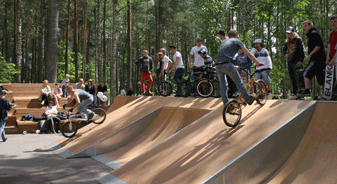 |
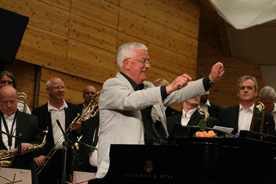 |
|
Latvian poets Rainis (1865-1929) and Aspazija
(1865-1943). Take a picture and put some flowers at the Rainis and Aspazija
monument (35 Jomas Street). Peace of mind can be obtained at the Art-Residence
Inner Light a theatre of Vitaly Yermolayev pictures, light and relaxing
music. The place features also a studio of meditative drawing for everyone and
exhibition shop of floristic design and light fittings.It is a real pleasure to
stroll along the pedestrian Jomas Street ! It is a promenade where people meet,
dine, watch and demonstrate fashionable gowns. Gourmands find here lovely cafes
and various national cuisines (Armenian, Russian, Ukrainian, Indian/Thai/Chinese
etc.).
The Blue Flag - an internationally known acknowledgement of clean swimming water
and good beach infrastructure is awarded to the Majori beach for many years in
turn.
DUBULTI where the river flirts
with the sea
Between Majori and Dubulti You find the two narrowest things in Jūrmala.The
curve coquettishly separating the river from the sea is only 320m wide! The
first inscriptions about Dubulti are dated with the 16th century, when the
Dubulti Inn was mentioned.
Dubulti is the oldest bathing place in Jūrmala the first summer residents
arrived in 1810. In 1844 steamboat traffic connected Rīga and Dubulti. For many
years Dubulti has been the administrative centre of Jūrmala. Numerous State and
Municipal institutions are found here now. Worth visiting is the Aspazija House
(20 Z. Meierovica Prospect), where the beloved Latvian poetess created and lived
the last years of her life.
JAUNDUBULTI and PUMPURI
feel the silence!
The calmness of Pumpuri attracted rich Germans in the middle of the 19th century
and construction works started here. Till the World War I there were the highest
rent prices.
MELLUŽI and ASARI
taste the strawberries
Melluži were indicated on the maps as an inn and fishermen“s village in the 17th
century. When a resort-house with 12 rooms, dining-room, billiards hall and
dancing floor was built in 1827, the area was called Karlsbad after the name
of Baron Carl Fircks, the Owner of the estate. Open-Air Stage, surrounded by the
Melluži Park, was one of the first places where the locals organized theatre
performances in Latvian. Popular dance music was often played by a brass band.
Melluži and Asari have always been known for gardening traditions. Strawberries
and raspberries grown here are famous for excellent taste and smell.
VAIVARI make friends with a horse.
Vaivari gained the significance of a district of Jūrmala after 1959 when Jūrmala
town was founded. Though, the name of Vaivari appeared in 1938 when the Asari II
railway station was renamed. The camping and open-air water attraction park Nemo,
located on the very sea-coast, attracts young and active travellers promising
accommodation and pleasant holidays for reasonable prices. Another special offer
of Vaivari is horse-riding facilities in the neighbourhood of the National
Rehabilitation Centre Vaivari. Reittherapy and riding lessons help kids and
adults to regain physical balance and self confidence.
KAUGURI - the largest dwelling area
Look back at the Latvian Battles of Liberation (1918-1920) and visit the
monument to Captain Pauls Zolts and his soldiers, erected in 1934 and renewed in
1989. Located in the dunes of Kaugurciems, it keeps the memory of those fallen
during one of the bloodiest battles on May 18,1919. Being the largest dwelling
area, Kauguri is getting ready for meeting tourists.
there are Saunas and Russian baths, new supermarkets, restaurants, cafes and
vegetables markets. If You do not have the opportunity to cook, go to the
ethnographically-styled cafe Kūriņš. The interior items remind of fishermen's
life.
JAUNĶEMERI the oasis of health
The nearness of the sea, vast pine forests, fresh air, mineral waters and
curative muds in combination with modern methods of diagnostics and treatments
explain why Jaunķemeri is so popular among people suffering from cardio-vascular
illnesses, support-movement apparatus problems, central and peripheral nervous
systems“ ailments, metabolism and gynaecological disorders. Two large and famous
health centres are located in Jaunķemeri.
ĶEMERI great future expectations
Ķemeri met its first inhabitants later than the other districts of Jūrmala.
Located far from other villages and towns, surrounded by bogs, the place did not
look attractive. The first documents mentioning the place date back to 1561 when
the peasant Kaspars Ķemeris was given a piece of land here. But the legend about
Ķemeri hydrogen sulphide water springs has a long history. One of them has been
called The Holy Spring. Since the 19th century Ķemeri springs became popular
in the medical circles. 1838 is considered to be the year of the health resort's
establishment as the first state baths were opened in Ķemeri and the resort
developed rapidly after that. In 1920-1930“s Ķemeri was one of the most
up-to-date European balneological resorts.
Today many components of the Ķemeri resort are under reconstruction. Fill a
bottle for takeaway at the curative sulphur water source Ķirzaciņa (The
Little Lizard). Sprinkle Your face and feel the difference
|


